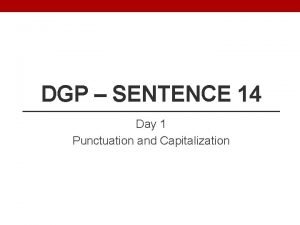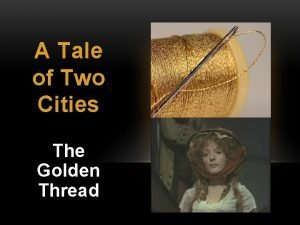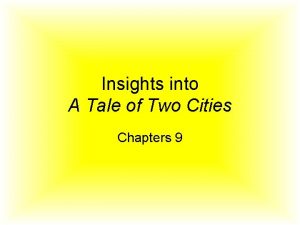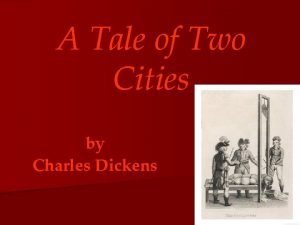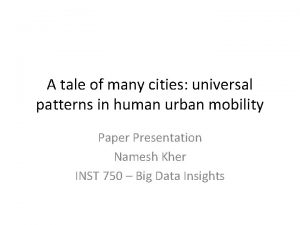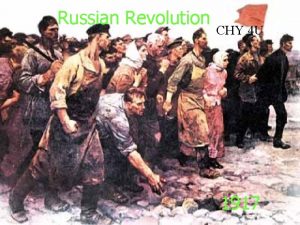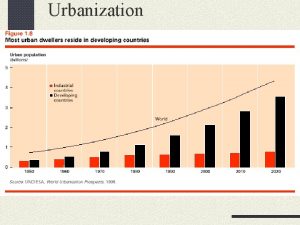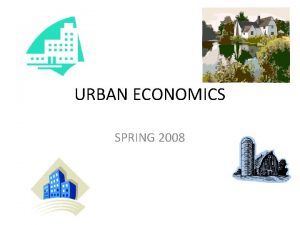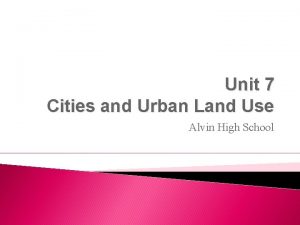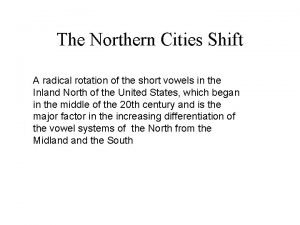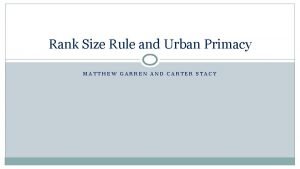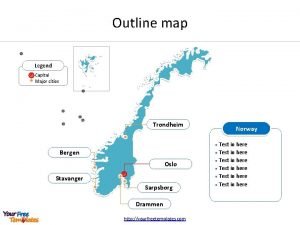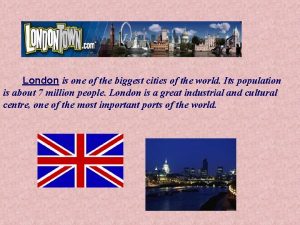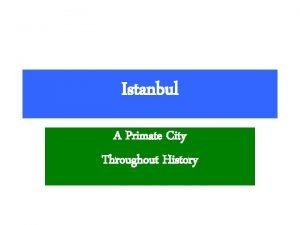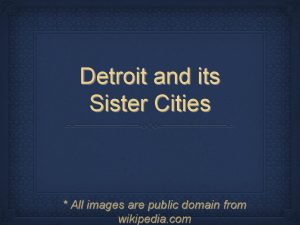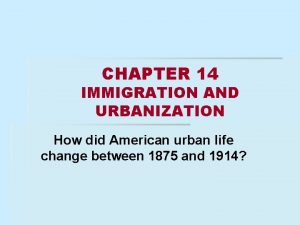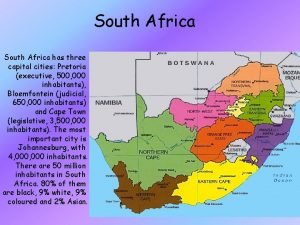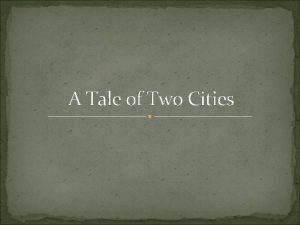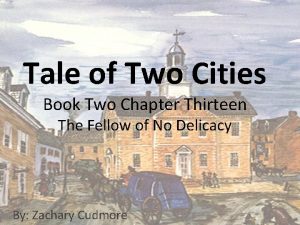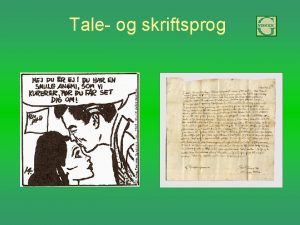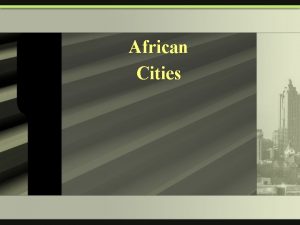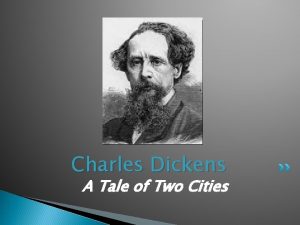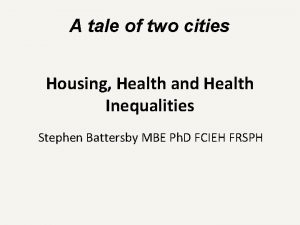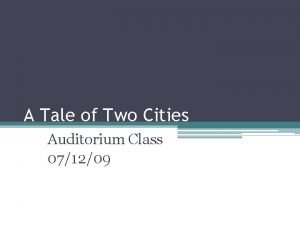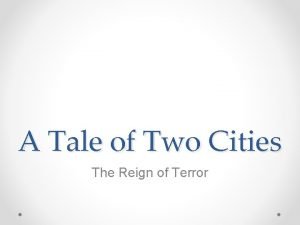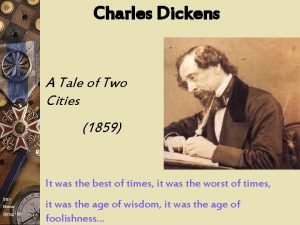A Tale of Two Cities A Tale of











































- Slides: 43

A Tale of Two Cities

A Tale of Two Cities It was the best of times, it was the worst of times, it was the age of wisdom, it was the age of foolishness, it was the epoch of belief, it was the epoch of incredulity, (skepticism) it was the season of Light, it was the season of Darkness, it was the spring of hope, it was the winter of despair,

A Tale of Two Cities As its title promises, this brief chapter establishes the era in which the novel takes place: England France in 1775. The age is marked by competing and contradictory attitudes—“It was the best of times, it was the worst of times”—but resembles the “present period” in which Dickens writes.

A Tale of Two Cities In England, the public worries over religious prophecies, popular paranormal phenomena in the form of “the Cock-lane ghost, ” and the messages that a colony of British subjects in America has sent to King George III. France, on the other hand, witnesses excessive spending and extreme violence, a trend that anticipates the erection of the guillotine. Yet in terms of peace and order, English society cannot “justify much national boasting” either—crime and capital punishment abound.

A Tale of Two Cities

A Tale of Two Cities

A Tale of Two Cities Charles Dickens, who spent the majority of his literary career penning the exploits of London underdogs, also happened to write a novel that has become crystallized in the public imagination as synonymous with the French Revolution.

A Tale of Two Cities - Overview Eighteen years ago, a French doctor was imprisoned without any warning (or any trial). He’s been locked up in the worst prison of all prisons, the Bastille. After almost two decades, he was released—again without any explanation—and he’s currently staying with an old servant of his, Ernst Defarge. Today, Mr. Lorry (that’s our British businessman) is on a mission to take the French doctor back to England, where he can live in peace with his daughter.

A Tale of Two Cities - Overview Dr. Manette may be free, but he’s still a broken man. He spends most of his time cobbling shoes and pacing up and down in his dark room. Too accustomed to the space of a prison to understand that he can actually leave his room, Dr. Manette seems doomed to live a pitiful life.

Dickens’ Life Dickens applied his unique power of observation to the city in which he spent most of his life. He routinely walked the city streets, 10 or 20 miles at a time, and his descriptions of nineteenth century London allow readers to experience the sights, sounds, and smells of the old city.

Dickens’ Life Victorian London was the largest, most spectacular city in the world. While Britain was experiencing the Industrial Revolution, its capital was both reaping the benefits and suffering the consequences. In 1800 the population of London was around a million souls. That number would swell to 4. 5 million by 1880.

Dickens’ Life While fashionable areas like Regent and Oxford streets were growing in the west, new docks supporting the city's place as the world's trade center were being built in the east. Perhaps the biggest impact on the growth of London was the coming of the railroad in the 1830 s which displaced thousands and accelerated the expansion of the city.

Dickens’ Life The price of this explosive growth and domination of world trade was untold squalor and filth. In his excellent biography, Dickens, Peter Ackroyd notes that "If a late twentieth-century person were suddenly to find himself in a tavern or house of the period, he would be literally sick - sick with the smells, sick with the food, sick with the atmosphere around him. "

Put on your Imagination Hat Imagine yourself in the London of the early 19 th century. The homes of the upper and middle class exist in close proximity to areas of unbelievable poverty and filth. Rich and poor alike are thrown together in the crowded city streets.

This ‘Ain’t’ Mary Poppins Street sweepers attempt to keep the streets clean of manure, the result of thousands of horse-drawn vehicles. The city's thousands of chimney pots are belching coal smoke, resulting in soot which seems to settle everywhere.

Who wants to drink THAT? In many parts of the city raw sewage flows in gutters that empty into the Thames. Street vendors hawking their wares add to the cacophony of street noises. Pick-pockets, drunks, beggars, and vagabonds of every description add to the colorful multitude.

Victorian England or 14 year old boy? Personal cleanliness is not a big priority, nor is clean laundry. In close, crowded rooms the smell of unwashed bodies is stifling. It is unbearably hot by the fire, numbingly cold away from it.

What about at night? At night the major streets are lit with feeble gas lamps. Side and secondary streets may not be lit at all and link bearers are hired to guide the traveler to his destination. Inside, a candle or oil lamp struggles against the darkness and blacken the ceilings.

Sanitation and Disease Until the second half of the 19 th century London residents were still drinking water from the very same portions of the Thames that the open sewers were discharging into. Several outbreaks of Cholera in the mid 19 th century, along with The Great Stink of 1858, when the stench of the Thames caused Parliament to recess, brought a cry for action.

Sanitation and Disease Cholera is spread simply by one human digesting the bacteria in the excrement of other infected humans. Sir Joseph Bazalgette, chief engineer of the new Metropolitan Board of Works (1855), put into effect a plan, completed in 1875, which finally provided adequate sewers to serve the city. In addition, laws were put in effect which prevented companies supplying drinking water from drawing water from the most heavily tainted parts of the Thames and required them to provide some type of filtration.

In the Streets A traffic count in 1850 showed a thousand vehicles an hour passing through these areas during the day. All of this added up to an incredible amount of manure which had to be removed from the streets. In wet weather straw was scattered in walkways, storefronts, and in carriages to try to soak up the mud and wet.

In the Streets Cattle were driven through the streets until the mid 19 th century. In an article for Household Words in March 1851 Dickens, with characteristic sarcasm, describes the environmental impact of having live cattle markets and slaughterhouses in the city:

Cattlemarkets and Slaughterhouses, oh my! "In half a quarter of a mile's length of Whitechapel, at one time, there shall be six hundred newly slaughtered oxen hanging up, and seven hundred sheep but, the more the merrier proof of prosperity. Hard by Snow Hill and Warwick Lane, you shall see the little children, inured to sights of brutality from their birth, trotting along the alleys, mingled with troops of horribly busy pigs, up to their ankles in blood but it makes the young rascals hardy. Into the imperfect sewers of this overgrown city, you shall have the immense mass of corruption, engendered by these practices, lazily thrown out of sight, to rise, in poisonous gases, into your house at night, when your sleeping children will most readily absorb them, and to find its languid way, at last, into the river that you drink. "

The Poor The Victorian answer to dealing with the poor and indigent was the New Poor Law, enacted in 1834. › Previously it had been the burden of the parishes to take care of the poor. The new law required parishes to band together and create regional workhouses where aid could be applied for. › The workhouse was little more than a prison for the poor. › Civil liberties were denied, families were separated, and human dignity was destroyed. The true poor often went to great lengths to avoid this relief.

The Poor Dickens, because of the childhood trauma caused by his father's imprisonment for debt and his consignment to the blacking factory to help support his family, was a true champion to the poor. He repeatedly pointed out the atrocities of the system through his novels.

Blacking Factory? Boot polish factory where 12 -year-old Dickens was sent to work, fixing labels to bottles of blacking, to help support his family. Dickens had dreams of becoming a gentleman and was humiliated working with the rough men and boys at the factory. The experience had a major impact on Dickens later life and works and also on his relationship with his mother who, after Charles left the factory as the result of a quarrel between his father and the owners of the factory, argued unsuccessfully to have him sent back. Dickens relates the misery he felt during this time in the fictionalized account of David Copperfield working at Murdstone and Grinby's warehouse.

The French Revolution Wow. EVERYTHING is turned on its head.

Causes of French Revolution Ideas of liberty and equality from the American Revolution (note: Constitution was signed 2 yrs before in 1787) Enlightenment ideas of John Locke

Causes of French Revolution Vast majority of people were broke and hungry. Vast majority were in the lowest estate

The Old Regime (Ancien Regime) • Old Regime – socio-political system which existed in most of Europe during the 18 th century • Countries were ruled by absolutism – the monarch had absolute control over the government • Classes of people – privileged and unprivileged – Unprivileged people – paid taxes and treated badly – Privileged people – did not pay taxes and treated well



Society under the Old Regime • In France, people were divided into three estates – First Estate • High-ranking members of the Church • Privileged class – Second Estate • Nobility • Privileged class – Third Estate • Everyone else – from peasants in the countryside to wealthy bourgeoisie merchants in the cities • Unprivileged class

Three Estates

bourgeoisie Part of the third estate, they were the “middle class” of France. They were bankers, merchants, factory owners (educated people) Led the revolution

Revolution - beginnings Although people were starving and the country was broke, the royal family flaunted their wealth and uncaring.

People were Bread riots hungry; the country was broke. This picture is from an allwoman bread riot. Marie Antionette said “let them eat cake”

King Louis XVI His grandfather Louis XIV was the ultimate “absolutist” king. This king was weak He had so little control, he called for the French congress to fix some problems

Estates General meets The part of the French Congress representing the third estate left and declared themselves THE congress of France.

Events continued French created their own Declaration of the Rights of Man and Citizen modeled after TJ’s Declaration of Independence

Effects of the French Revolution Both the King and Queen were beheaded French monarchy no more In addition to the Royal family, 17, 000 people were executed with the guillotine.

The French Revolution But how did it all happen? Next week.

 Literary devices in tale of two cities
Literary devices in tale of two cities In the novel a tale of two cities dgp
In the novel a tale of two cities dgp The golden thread a tale of two cities
The golden thread a tale of two cities Allusion in a tale of two cities
Allusion in a tale of two cities A tale of two cities summary
A tale of two cities summary A tale of many cities
A tale of many cities Mecca is a city in ________.
Mecca is a city in ________. Characteristics of folk literature
Characteristics of folk literature Activity sheet 3 a tale of two chocolate companies answers
Activity sheet 3 a tale of two chocolate companies answers Abdecario
Abdecario A tale of two revolutions grade 10, 1080l
A tale of two revolutions grade 10, 1080l A tale of two revolutions grade 10, 1080l
A tale of two revolutions grade 10, 1080l Story of two pebbles
Story of two pebbles Alpha beta gamma cities ap human geography
Alpha beta gamma cities ap human geography Primate cities
Primate cities Why do cities exist
Why do cities exist Folk preliterate cities
Folk preliterate cities Men's center
Men's center Northern cities shift
Northern cities shift What is the correct equation for cellular respiration?
What is the correct equation for cellular respiration? How many capital cities in south africa
How many capital cities in south africa Cities on hills
Cities on hills North central plains climate
North central plains climate Rank size rule equation
Rank size rule equation Primate city and rank size rule
Primate city and rank size rule Map of norway with major cities
Map of norway with major cities Major cities in scotland map
Major cities in scotland map Unit 3 asl vocab
Unit 3 asl vocab London is one of the biggest cities in the world
London is one of the biggest cities in the world Major cities in the appalachian region canada
Major cities in the appalachian region canada Is istanbul a primate city
Is istanbul a primate city Positive effects of primate cities on economic development
Positive effects of primate cities on economic development Fox cities exhibition center
Fox cities exhibition center Detroit's sister city
Detroit's sister city What luxuries did cities offer to the middle class
What luxuries did cities offer to the middle class Mdc vs ldc
Mdc vs ldc Dangerous cities in the world
Dangerous cities in the world Urbanisation in contrasting global cities
Urbanisation in contrasting global cities Beach cities scuba cypress
Beach cities scuba cypress Cities in wales
Cities in wales What do you do to keep your city clean
What do you do to keep your city clean Union of baltic cities
Union of baltic cities Mee kam ng
Mee kam ng Three capital of south africa
Three capital of south africa

